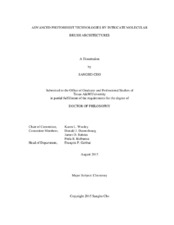| dc.description.abstract | With recent technological improvements, fabrication of integrated circuit elements on shrinking scales is required to meet the demand for massive storage and fast data processing. As the fabrication of high resolution patterns requires short wavelength radiation sources, extreme ultraviolet and electron beam techniques have been developed as radiation sources for next-generation lithography. Advancements of lithography techniques accompany the evolution of resist materials for the synchronous fulfillment of high sensitivity, high resolution, and high structural integrity. Our strategy for nanofabrication is a combination of bottom-up synthesis and top-down lithography. The use of cylindrical brush polymers, which can vertically align on substrates, affords access to electron-beam-generated patterns with the minimum pixel size determined by the cylinder diameter.
Cylindrical brush polymers for negative- and positive-tone photoresist materials were synthesized by controlled radical and olefin metathesis polymerization. Macromonomers with well-defined size variations were prepared by reversible addition-fragmentation chain transfer polymerization of monomers having surface energy reducing, substrate adhesion enhancing, and lithographically functioning moieties. Then, sequential ring-opening metathesis polymerization of the macromonomers via a “grafting-through” strategy allows precise control of concentric and lengthwise dimensions and compositions in the brush polymer structures.
The brush polymers consist of a rigid polymeric backbone with covalently tethered side chains which allow facile access to a cylindrical morphology due to their steric repulsion. Low surface energy of fluoropolymers at one end and the high polarity of groups at the other end drive the cylindrical brush polymers to vertically align on the polar silicon wafer substrate as characterized by surface analysis techniques. The stretched conformation of the brush polymers facilitates their assembly by reducing chain entanglement.
The chemically amplified resists from the brush polymers exhibit high lithographic performance with a few tens of nanometer resolution. The brush polymers with poly(p-hydroxystyrene)s yielded negative-tone features by crosslinking chemistry, while those having acid-labile tertiary esters gave positive-tone features. Cylindrical brush polymer based resists showed their superior lithographic performance over linear block copolymer precursors in both resolution and sensitivity by having each vertically aligned molecule act as a molecular pixel. As a result, the tuning of composition and dimension using bottom-up synthetic strategy allows the fine tuning of top-down lithographic performance.
Cylindrical brush polymers for negative- and positive-tone photoresist materials were synthesized by controlled radical and olefin metathesis polymerization. Macromonomers with well-defined size variations were prepared by reversible addition-fragmentation chain transfer polymerization of monomers having surface energy reducing, substrate adhesion enhancing, and lithographically functioning moieties. Then, sequential ring-opening metathesis polymerization of the macromonomers via a “grafting-through” strategy allows precise control of concentric and lengthwise dimensions and compositions in the brush polymer structures.
The brush polymers consist of a rigid polymeric backbone with covalently tethered side chains which allow facile access to a cylindrical morphology due to their steric repulsion. Low surface energy of fluoropolymers at one end and the high polarity of groups at the other end drive the cylindrical brush polymers to vertically align on the polar silicon wafer substrate as characterized by surface analysis techniques. The stretched conformation of the brush polymers facilitates their assembly by reducing chain entanglement.
The chemically amplified resists from the brush polymers exhibit high lithographic performance with a few tens of nanometer resolution. The brush polymers with poly(p-hydroxystyrene)s yielded negative-tone features by crosslinking chemistry, while those having acid-labile tertiary esters gave positive-tone features. Cylindrical brush polymer based resists showed their superior lithographic performance over linear block copolymer precursors in both resolution and sensitivity by having each vertically aligned molecule act as a molecular pixel. As a result, the tuning of composition and dimension using bottom-up synthetic strategy allows the fine tuning of top-down lithographic performance. | en |


